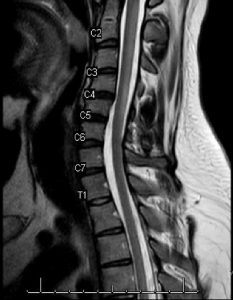William Rushton, FACEP, FACMT
Office of Medical Toxicology
University of Alabama Birmingham
Medical Director
Alabama Poison Information Center, Children’s of Alabama
Background: Nitrous oxide (N2O), or “laughing gas,” is an intoxicant that is used in recreational highs. Commonly known as whippets, nitrous oxide chargers found in whipped cream canisters are filled with nitrous oxide which catalyzes a euphoric effect when inhaled. Unfortunately, as this case demonstrates, chronic nitrous oxide abuse can also lead to severe debilitating consequences.
Case: A 28 year-old male presented to the emergency department with inability to ambulate and paresthesias in his bilateral lower extremities. He reported abusing N2O for one month, sometimes inhaling 200 commercial grade cannisters “whippets” daily. Due to a history of nitrous oxide abuse, a vitamin B12 level of 125pg/mL [ref: 180-914 pg/ml] was obtained. He was initially treated with a single vitamin B12 injection. After discharge, he continued to inhale N2O and was subsequently admitted for severe proprioceptive and vibratory loss in all extremities. Initial labs were notable for hematocrit of 36%, negative infectious studies, and vitamin B12 level less than the range of detection. He was again treated with intramuscular vitamin B12 for two weeks without clinical improvement and then transferred to a tertiary care center whereupon his vitamin B12 was 270pg/mL. MRI of the cervical spine (see figure 1) demonstrated diffuse signal abnormality involving the dorsal spinal cord and associated enhancement. Due to lack of improvement, he was treated with 5 doses of IVIG, along with daily intramuscular vitamin B12 and occupational therapy. He symptomatically improved, and after one week, his repeat vitamin B12 level was >1500pg/mL. He was transferred to acute inpatient rehabilitation for 10 days, after which he could ambulate with minimal assistance.
Discussion: Unfortunately, nitrous oxide can lead to a variety of detrimental effects. It has a much higher water solubility than nitrogen, and thus when closed airspaces such as Eustachian tubes or the mediastinum are encountered, nitrous oxide can diffuse out of the blood with much higher pressure than nitrogen, causing tympanic membrane rupture, pneumothorax, and pneumomediastinum. Methionine, a crucial amino acid, synthesis is also inhibited, preventing cellular replication, and leading to bone marrow suppression. N2O permanently reduces vitamin B12 to an oxidized form, leading to a disabling polyneuropathy. As is the case in the above patient, MR findings often demonstrate abnormal signals in the posterior and anterior spinal column. Standard treatment includes high dose vitamin B12 and methionine, if available. Unfortunately, recovery from subacute combined degeneration may be slow and incomplete even after treatment with vitamin B12.
Conclusions: In patients with idiopathic polyneuropathy and/or bone marrow suppression, emergency physicians should consider inquiring about drugs of abuse, particularly whippets or nitrous oxide abuse. A low B12 concentration may aid in confirmatory diagnosis. The Alabama Poison Information Center (APIC) may be contacted to assist in the diagnosis and treatment of these patients at 1-800-222-1222.
 Figure 1: Sagittal T2-Weighted MR of Patient’s Cervical Spine with Contrast Showing diffuse signal abnormality involving the dorsal spinal cord extending from the superior aspect of C2 to the inferior aspect of the C6 vertebral body level and associated enhancement.
Figure 1: Sagittal T2-Weighted MR of Patient’s Cervical Spine with Contrast Showing diffuse signal abnormality involving the dorsal spinal cord extending from the superior aspect of C2 to the inferior aspect of the C6 vertebral body level and associated enhancement.
